Designing Cross Stitch Patterns
This week, I have something very different than before: cross stitch!
Buy my first commercial design Primavera from my Etsy shop called Needle and Peony!

There are two main reasons for designing this pattern. The first is the need for creative play and the second that I couldn’t find anything like this from other designers: a fantasy woman’s facial portrait that wouldn’t be a huge project.
Playing and Drawing in the Stitchly App
My need for creative play comes from being very serious with art this year. I have spent a lot of time in programming computer art and I have been painting a bit too. It’s all great but I started to miss drawing, and especially, making something that is purely illustrative and not so abstract and artistically challenging.
So because I have had cross stitching as a hobby almost all my life, I bought an app called Stitchly and started drawing there – on lunch breaks and such, a few stitches at time. First I just doodled freely with the Apple pen to get to know the app.
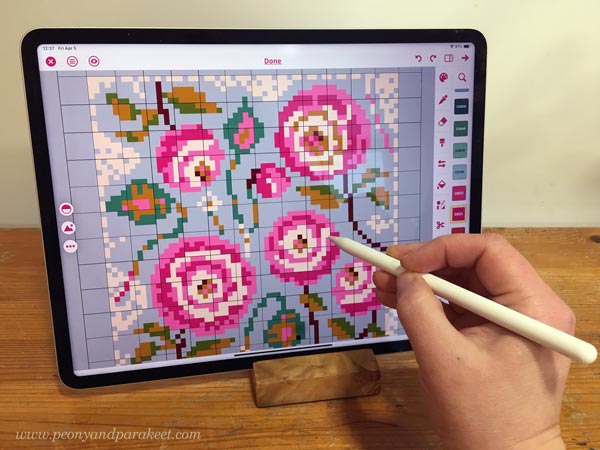
Stitchly is easy to use and with the pen, drawing is fun and the squares get filled nicely. Of course, you can also import a photo and let the app create the chart automatically. But to make the image look realistic enough, the stitch count needs to be high and the design … well I don’t think it would be a design anymore, just a pixelated photo. So, when I design, I like to draw with the pen and if I use references, I only use them as inspiration and draw every square myself.
I also like that you can have a custom palette in Stitchly. I have made a palette that has all the DMC colors from my stash, so I can also check the real color when designing.
Drawing and Stitching Faces
When people begin drawing in adulthood, they often start with faces. Eyes, mouth, nose too. Facial features create a connection to the person born on paper. It’s also fun to draw hair and add decorations there.
So, one day it hit me that even when doing cross stitches, I can get company from the character I am stitching. However, couldn’t find a cross-stitch pattern that was a reasonable size and where the character was naturally asymmetrical, but still sparked the imagination.
My stitching time is lonely time in the evening. I clean the studio if I have been painting, and then pick extra glasses and while stitching, watch other cross stitchers’ videos on Youtube, so Flosstube as we cross stitchers call the channels.
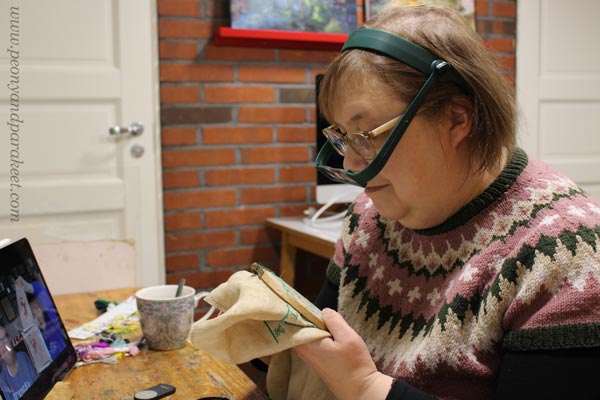
So when I wanted to stitch a facial portrait of an imaginary person, I decided to draw it in Stitchly. After making the chart, the fun started – I was stitching my own pattern!
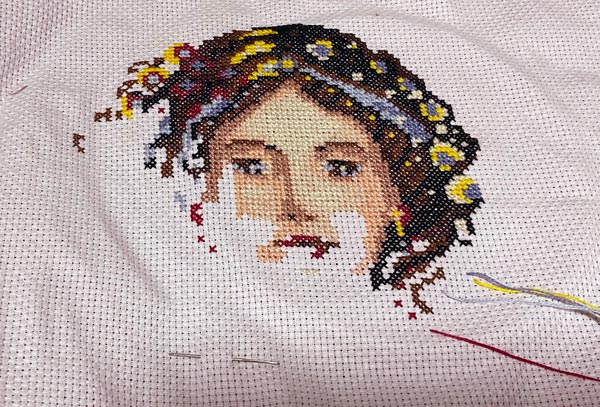
Primavera can be stitched in the colors I suggest in the pattern, but since there are only 11 colors, it’s easy to change them as you like.
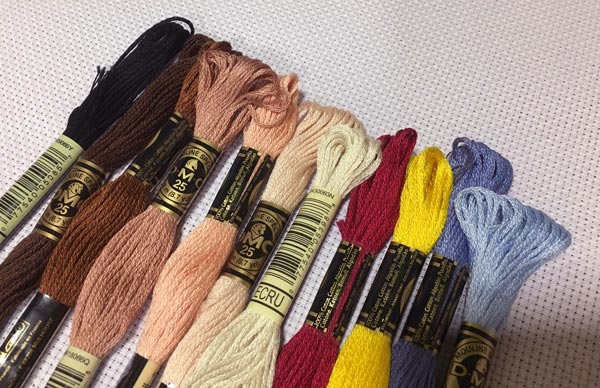
Although Primavera means spring, by changing the colors you can associate a different season or different theme with the character. The decorations are designed to be so general that they don’t limit the character you create.
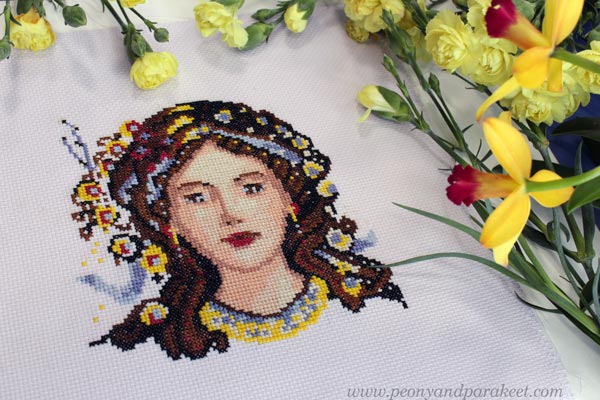
The hair has three colors of different darkness, the skin has four. The hair band has two colors close to each other. It is easy to change the accent colors of the mouth and eyes, and also the colors of the decorations.
You can buy the pattern for Primavera in my Etsy shop!
Needle and Peony
It feels nostalgic to have something on sale at Etsy again! Long before I became a full-time artist, I opened the Etsy shop called Kukkilintu, then later changed the name to Peony and Parakeet. That little shop had a major impact on my career and life. Most of my customers lived outside Finland and I started communicating more and more in English.
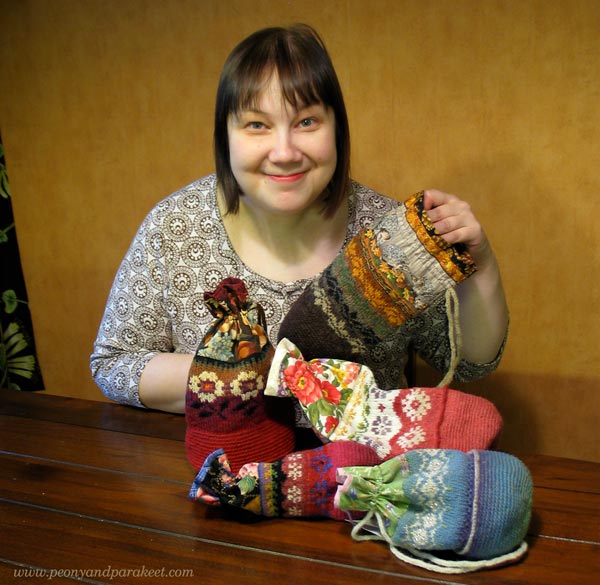
Maybe some of the current readers of this blog were my customers over ten years ago when I sold folk bags (currently available as a knitting pattern), handknitted doll clothes, hand-decorated papers and cards!
Now I changed the shop name to Needle and Peony and intend to add some charts over time. Maybe some slow stitching ideas also, as I have some of them too. Last week, I set up an Instagram account called @needleandpeony to show my cross stitch projects – also what I have stitched from other designers.
My other instagram accounts are @peonyandparakeet for fine art, @paivipeony for quilting, and @paivipioni for knitting.
Which Design Should I Do Next?
While designing Primavera, it hit me that I have a pile of drawings that I have made for classes and that could be turned into cross stitch patterns. When I browsed them, I couldn’t decide what to choose next, so I now ask you – what would you like me to design next? I have picked 5 drawings to choose from, leave a comment and let me know which one is your favorite! Which one of these would make a great cross stitch design?
A) Angel
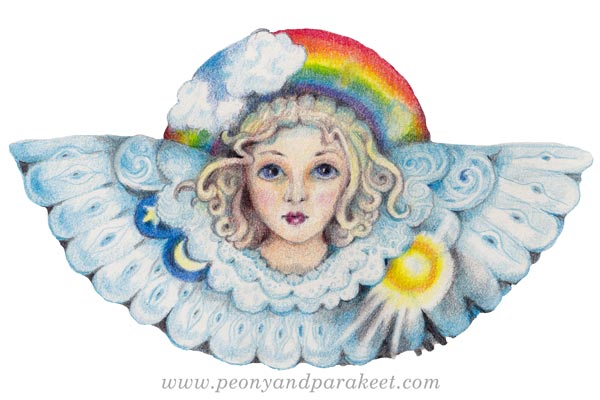
See how I drew the angel in 2022: Angel Drawing for the Inner Child
B) Girl
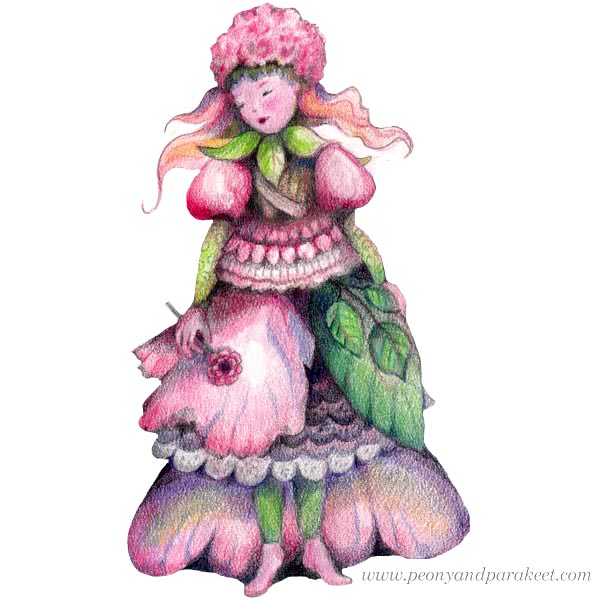
This flowel girl was drawn for the course Doll World.
C) Cat
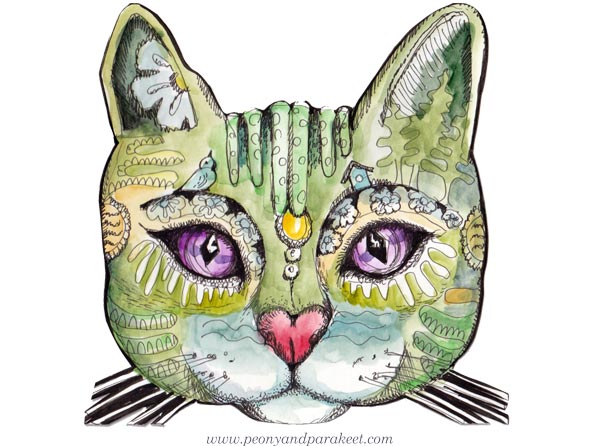
This cat was drawn for the course Magical Inkdom.
D) Leaf
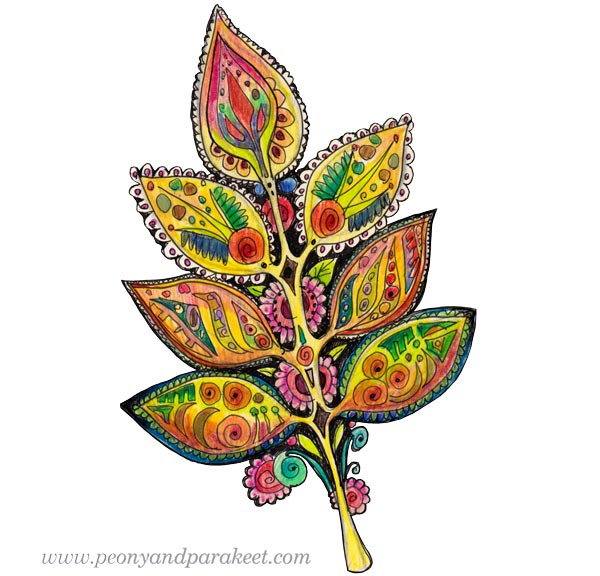
This folk leaf is an older design, from 2015. See more: Art Quilts in a Modern Way
E) Horse
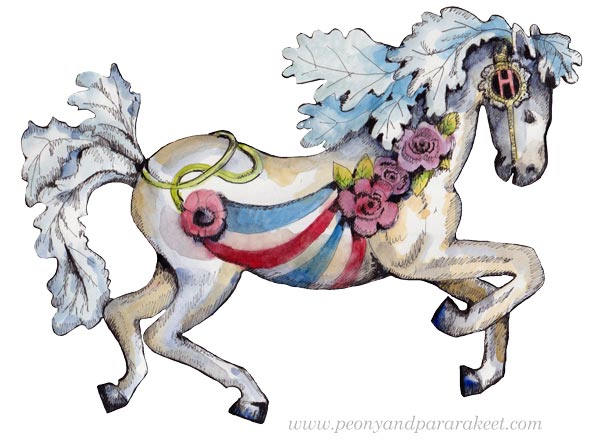
This fantasy horse was drawn for the course Magical Inkdom.
Tell me your favorite of the five – A) Angel, B) Girl, C) Cat, D) Leaf, or E) Horse?
Support me in the cross stitch design journey, here’s the link to purchase Primavera!
12 Spring Art Ideas from Over the Years
This week, I share spring-themed art from the past 10 years and give ideas for creating spring art.

There’s a variety of ideas and I hope everyone can find some that inspire to get creating!
#1 – For Beginners and Dull Moments
Doodle spring flowers with the mindset “more is more”!
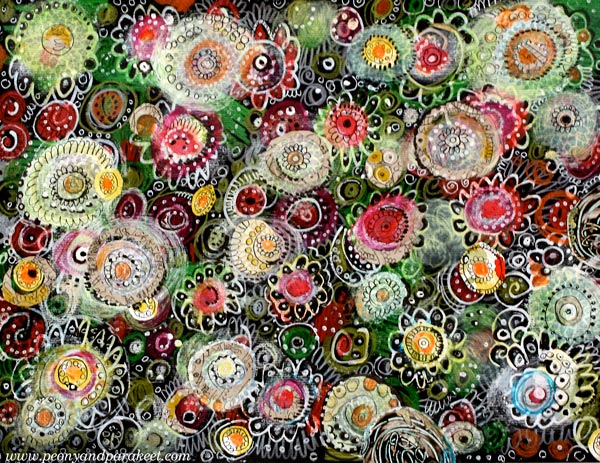
See the blog post: Subconscious Art
Course recommendation: Collageland
#2 – For Self-Explorers
Express your spring energy by following this step-by-step exercise: Bursting Circle
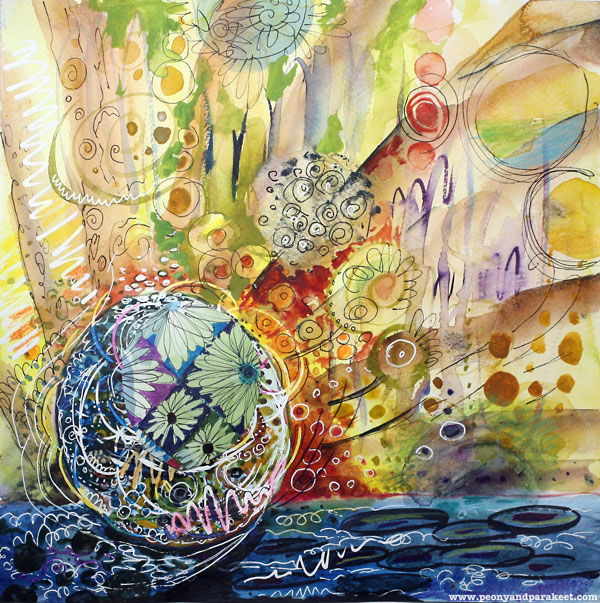
See the blog post: Bursting Circle
Course recommendation: Inspirational Drawing
#3 – For Free Spirits
Splash color and let everything grow from there!
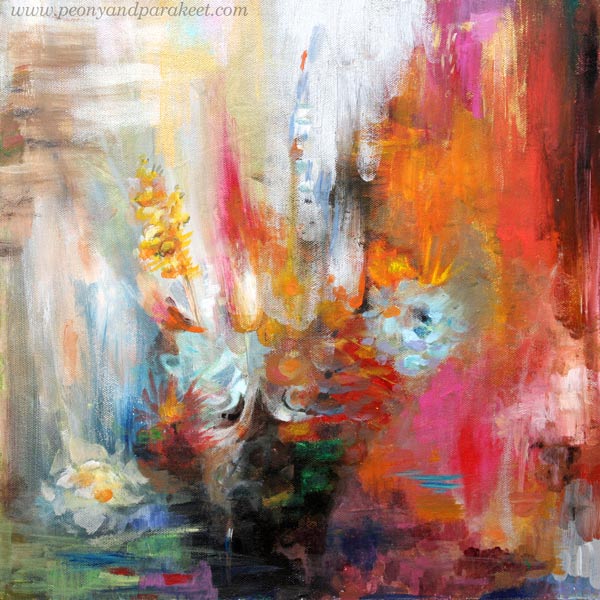
See the blog post: Art is Freedom
#4 – For Those Who Want to be Freer
When you want to be freer, the art of seeing is as important as the art of creating.
See the video of making “March Still Life”: Painting in Liberated Style

See the blog post: Painting in Liberated Style
Course recommendations: Liberated Artist Revisited and Freely Grown
#5 – For Minimalists
Pick a small piece of watercolor paper, moisten your watercolor pans, and let water do the trick.
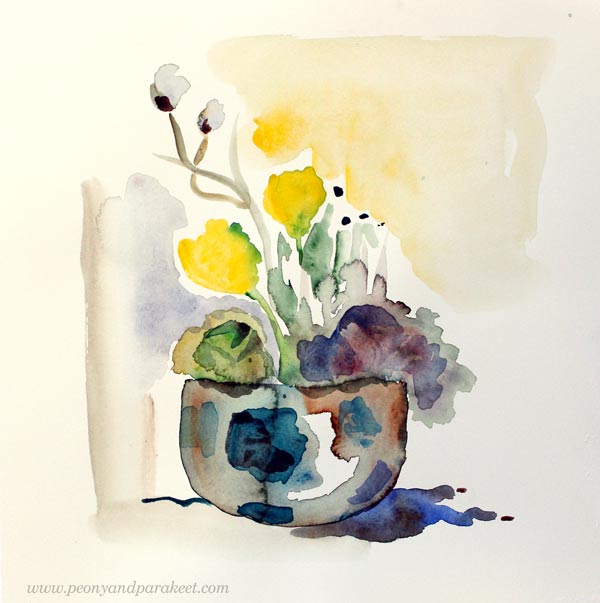
See the blog post: Easter Still Lifes in Watercolor – Video Included!
#6 – For Travelers
Paint a spring panorama. More examples: Watercolor Panoramas to Express Travel Memories
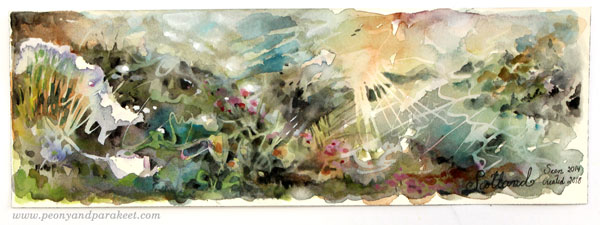
See the blog post: Watercolor panoramas to Express Travel Memories
Course recommendation: Watercolor Journey
#7 – For Beautiful Mess-Makers
Beautify the mess by adjusting the details: paint frilly edges and draw fine lines!
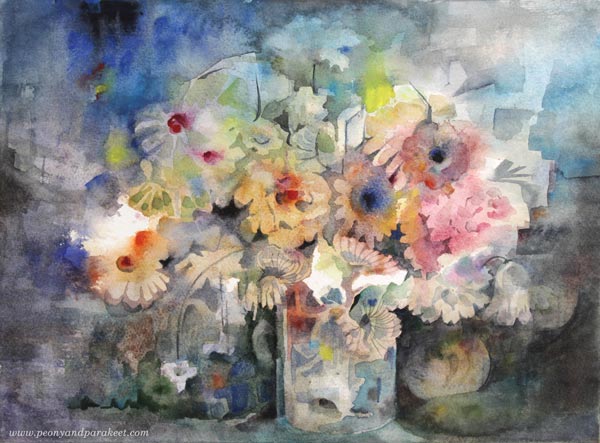
See the blog post: Freely Born Watercolor Florals
Course recommendations: Floral Fantasies and Freely Grown
#8 – For Journalers
Decorate a journal cover with your original art! See more instructions in this blog post: Painted Paper Collage
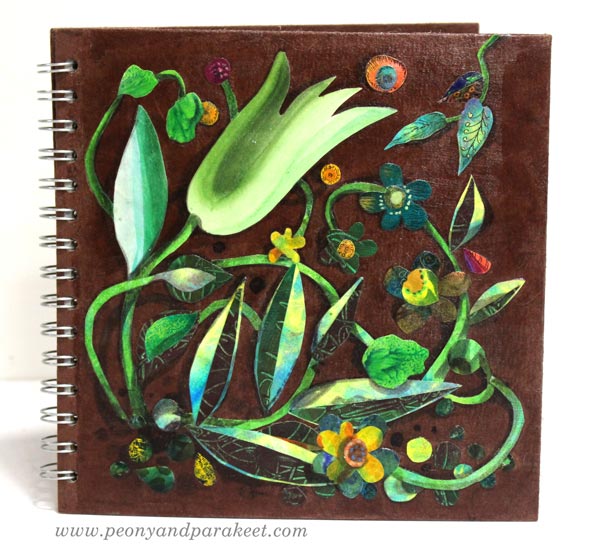
See the blog post: Painted Paper Collage – 6 Tips for Intricate and Fun Art
Course recommendations: Collageland and Decodashery
#9 – For Bird Watchers
Take this challenge to move from illustration to fine art:
Step out of your comfort zone and think about a bird shape as a canvas for expressing its surroundings.

See the blog post: Pros and Cons of Becoming an Artist
Course recommendation: Floral Freedom
#10 – For Art Lovers Who Procrastinate
Reduce watching those photo-realistic colored pencil videos and start coloring freely. One heart shape can lead to many and start your flight to the world of imagination!

See the blog post: 5 Reasons Why I Love Colored Pencils
Course recommendations: Intuitive Coloring and Fun Botanicum
#11 – For Wannabe Fantasy Artists
Find the story first, then its surroundings! A character is not only described by his face.

See the blog post: Wonderland Art – Inspiration from Alice in Wonderland
Course recommendations: Magical Forest and Magical Inkdom
#12 For Artists at Heart
Our creativity has winter and spring too. We need each other to keep the inspiration going – to turn the winter into spring.
A challenge for you: How can you make a new start – create a new spring for your art?
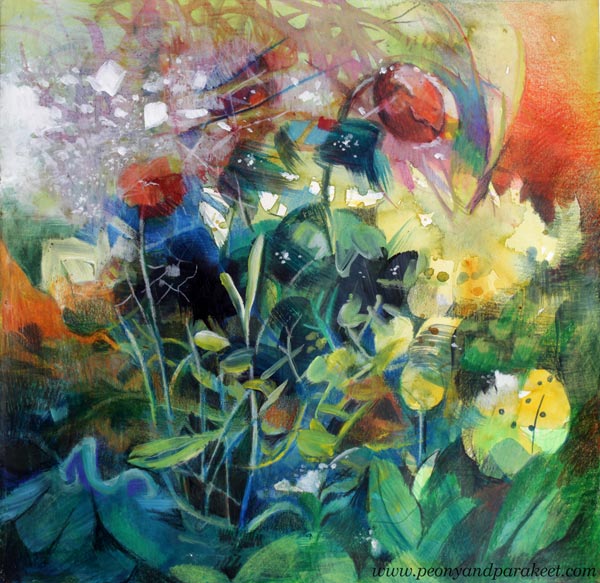
See the blog post: New Beginnings in Art-Making
Course recommendations: Liberated Artist Revisited
Bonus Idea #1: Spring Art Display
Gather your art on a side table for display! Make a collection of all kinds of pieces – even the smallest drawings and collage pieces can look fun this way.
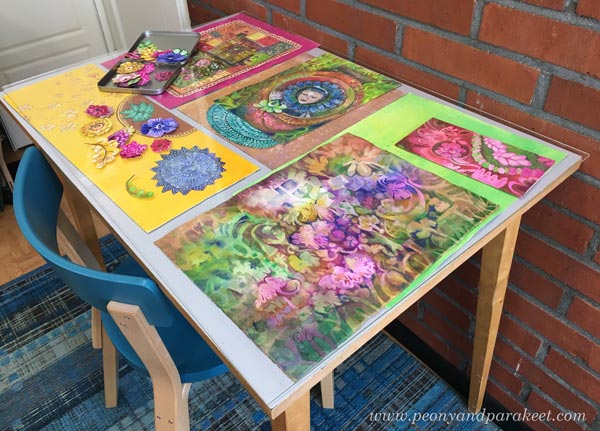
I have a plastic plate that is the same size as my table.
It protects my art, and it also protects the tabletop when painting in watercolor.
Bonus Idea #2: Listen to This!
I also have a music recommendation: “Kevät”
Kevät is spring in Finnish and the song was presented by a Finnish girl band Tavaramarkkinat in 1985. Here’s an English translation of the lyrics. The tone of the song is melancholic. This kind of controversy between melancholy and joy is one of the most inspiring things in spring, I think!
P.S. PostScript for Spring Art Ideas
We still have a lot of snow in Finland, and I miss spring so much! In these spring art ideas, I wanted to combine my yearning for spring and the celebration of being a full-time artist for ten years. The actual anniversary is in September, but I want to celebrate this life span the whole year of 2024.
One part of the celebration has been making the course Liberated Artist Revisited where I invite you to paint with me – to follow directions from Paivi many years ago, and then create more with the current Paivi. At the same time, you can ponder, how your art-making has changed and will change.
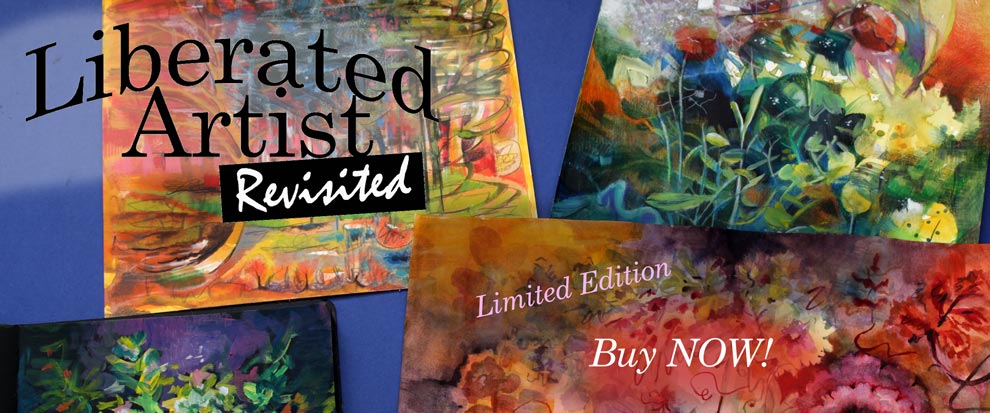
Because of the 10-year celebration and the nature of personal stories, Liberated Artist Revisited is a limited edition – only available for purchase until the end of March 2024! >> Buy Now!
Ninety-Ninety Rule for Art-Making
This week, we talk about the agony that’s associated with finishing.

Last fall, I had a turning point when I started making digital art. I’m not giving up painting, though. There will be just fewer oil paintings this year.
New Start
This year’s first oil painting started already in October last year. First, I made a mess with pastel hues. Then I began to figure out what kind of personality the painting could be.

This kind of intuitive painting is wonderful and for example, my latest course Liberated Artist Revisited is based on it. Instead of the model, we study the painting itself and let it go in its own direction.

When I paint, I often listen to some talk or music program at the same time, that’s why the iPad is also visible in these pictures.
Ninety-Ninety Rule
Programming and painting have a lot in common. One of those is definitely the ninety-ninety rule. It states that 90 percent of the work is done effortlessly and takes only 10 percent of the time. And the remaining 10 percent is difficult and takes 90 percent of the time!

For example, in this part of the painting my intuition was working fluently, and finishing these details was also easy. I especially like that beige flower near the edge.

But the further the painting progressed, the less often I worked on it. I wasn’t satisfied with the center and the soul of the painting was missing. I looked at it every day, but all my ideas seemed too ordinary.
Then when I finished the video artwork last week, I suddenly got ideas for the painting. First, I brought similar greenish tones and then, by keeping my mind on the video, I solved the puzzle stroke by stroke!

The name was now easy to find: Käännekohta – Turning Point.

The ninety-ninety rule applies to the fond factor as well. It’s easier to like an unfinished painting than one that is close to a finish. When under 90 percent, you can see the potential and ignore the unpleasant parts by saying that the piece is not ready yet. When working on the last 10 percent, things get more complicated and there are times when you hate the piece!
Old Supports New
During big changes, I have often thought that I leave the old completely and jump fully into the new. But this time I feel that the old and the new support each other.
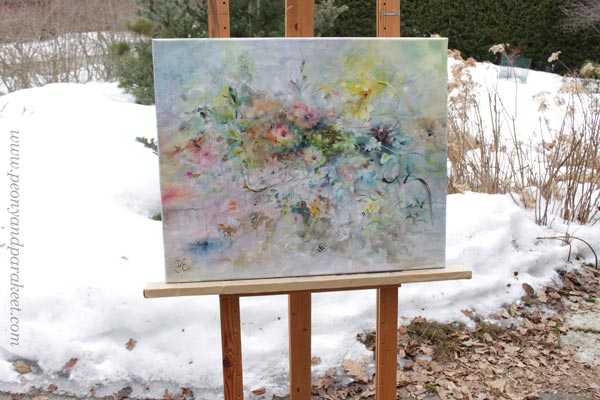
Life is an interaction between the past and the present and that applies to art-making as well.
Liberated Artist Revisited
With the newest course Liberated Artist Revisited, I invite you to paint with me – to follow directions from Paivi many years ago, and then create more with the current Paivi. At the same time, you can ponder, how your art-making has changed and will change.

Liberated Artist Revisited is a limited edition – only available for purchase until the end of March 2024! >> Buy Now!
Artist’s Life – Starting New Media Art
This week, I share my latest new media art and thoughts about my career as an artist. This is a sequel to the blog post called Beginner’s Video Art that was published last month.
Unstill Still Life – Video Art
The video above is my latest artwork “Unstill Still Life.” I have done this largely by programming. I have developed generative algorithms that create and alter shapes. I have designed the individual shapes with a 3D modeling program called Blender. The models and the code are put together with the Unity Engine which is a software environment for developing games.
Inspiration from an Old Painting
With the artwork, I participated in the Finnish National Gallery’s Web3 community Alusta challenge called “Nature and Nourishment.” The Finnish National Gallery has many copyright-free images and the organization encourages artists to use them for creating new media art.
I have taken inspiration for the colors and surfaces, as well as the concept itself, from Fanny Churberg’s 1876 painting “Still Life with Vegetables and Fish.”
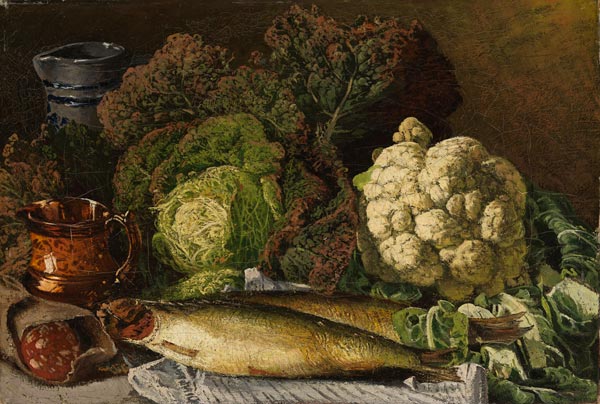
I love old paintings, so this challenge was made for me. It’s so interesting to examine the brush strokes and think about the 3-dimensional shapes that they are related to. And I have so much to learn in making generative art, that I need small challenges to keep heading forward.
I Will Continue Painting, But …
I am still going to continue painting traditionally but I also want to start a career in new media art. I want to bring back my skills in programming from the years when I was a software engineer and use those for creating art. I also have a degree in Industrial Design that helps a lot with 3D modeling. The grant that I received from The Finnish Cultural Foundation has enabled me to develop my style in new media.
But all this is not only exciting but hard too. Do you know that feeling that comes when you have to start life over again? There is enthusiasm in the air, but also some “oh no”.
Building a CV
For a full-time artist, most opportunities are based on a CV.
That was not a problem when I graduated in software design in 1996. I thought: “I have plenty of time to grow my CV.” Then, when I graduated as an industrial designer in 2009, life seemed to be halfway over, but I was able to get quite a decent CV by combining some old and new projects.
When I started working as a full-time visual artist in 2014, I didn’t think about CVs at all at first.
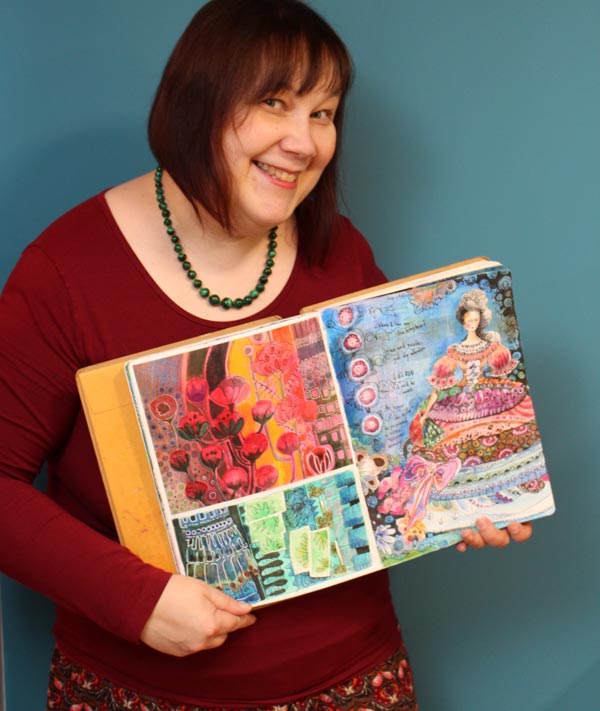
The picture above is from 2015 when most of my art was in art journal pages.
But when I moved forward in painting, the reality hit me – it was very hard to get accepted to exhibitions and organizations without a CV. Mine was practically blank at first, and it has taken a lot of time and effort to add rows to it.
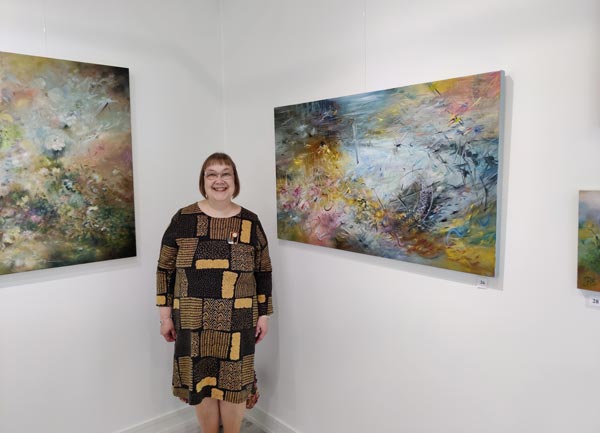
The picture above is from last summer at the exhibition organized by The Albert Edelefelt Foundation. See more pics in this blog post!
New Media Art – New Career?
And just when I thought that life was almost over at the age of 55, this new media digital art came into my life and it hit me – I’m a beginner again with an empty CV. So, I need and want to participate in challenges, competitions, and exhibitions, to get accepted again. And I want to believe that I still have time to create this new kind of art, not only paintings.

Some leaves of the big plant are connected to an invisible virtual camera that moves around and sends a mirror image to them.
I learn new things about generative art every day and I am amazed that I have been given this long life to experience it. Gratitude is the overriding emotion that emerges from this new beginning. I am lucky in what I have seen in the development of information technology and what I have been able to develop and be involved in developing in the past. I want my future CV to tell the story of a girl who wanted to become an artist as a child, who fell in love with computers as a teenager, and who finally has the artistic vision and the technical tools to combine the two.
Looking Back Enables Seeing Forward
If you have been following my blog for a while, you must have noticed that my blog posts are often self-reflective like this one. Visual art-making needs self-reflection too. It’s useful to go back and see how things have changed to make future changes and take steps forward.
With the newest course Liberated Artist Revisited, I invite you to paint with me – to follow directions from Paivi many years ago, and then create more with the current Paivi. At the same time, you can ponder, how your art-making has changed and will change.

Liberated Artist Revisited is a limited edition – only available for purchase until the end of March 2024! >> Buy Now!